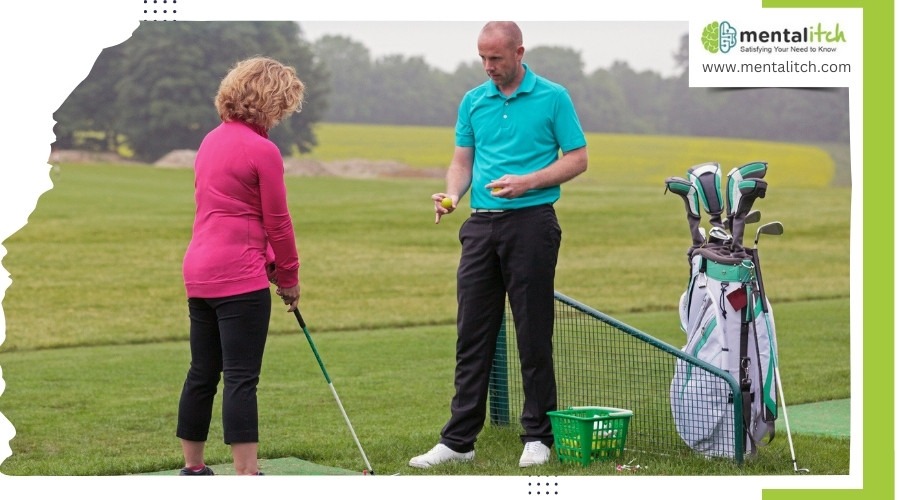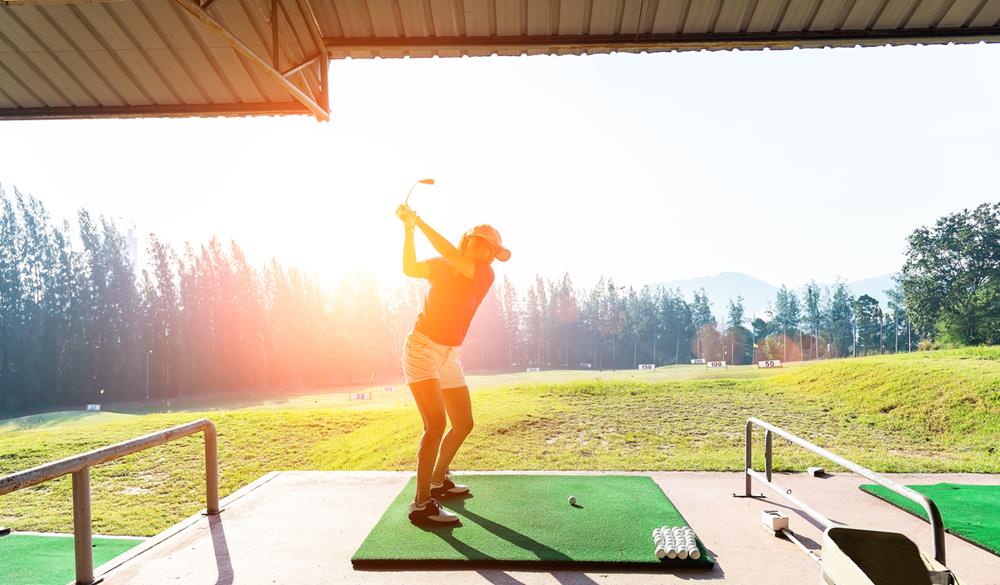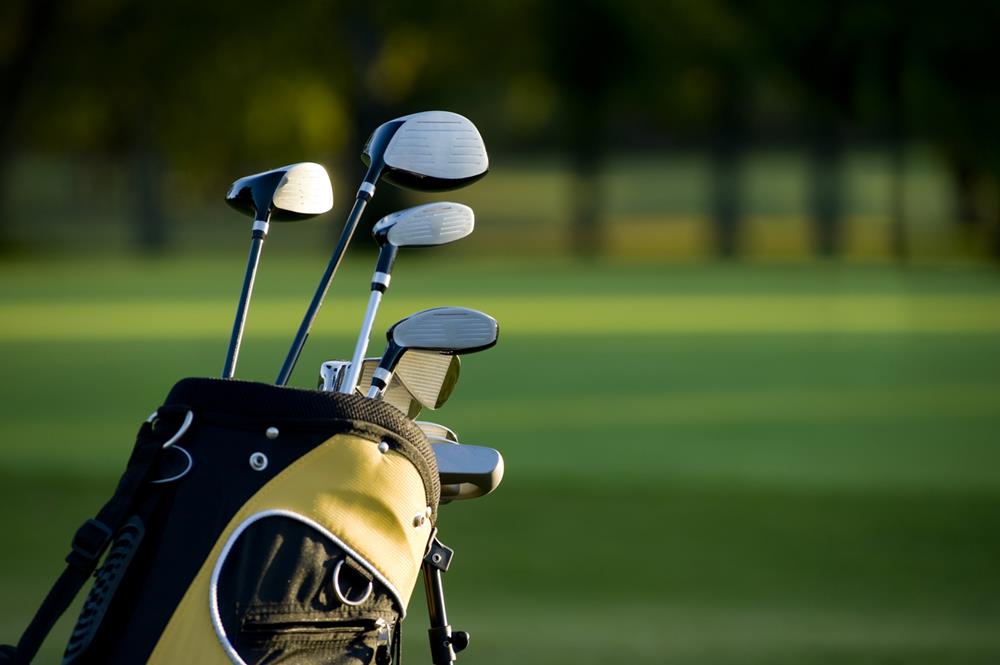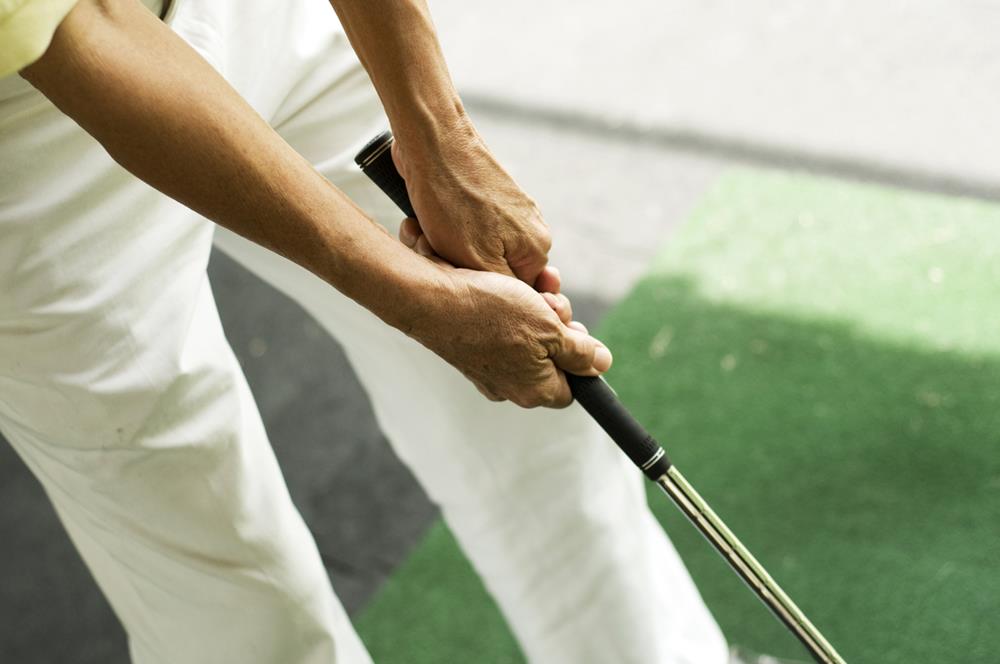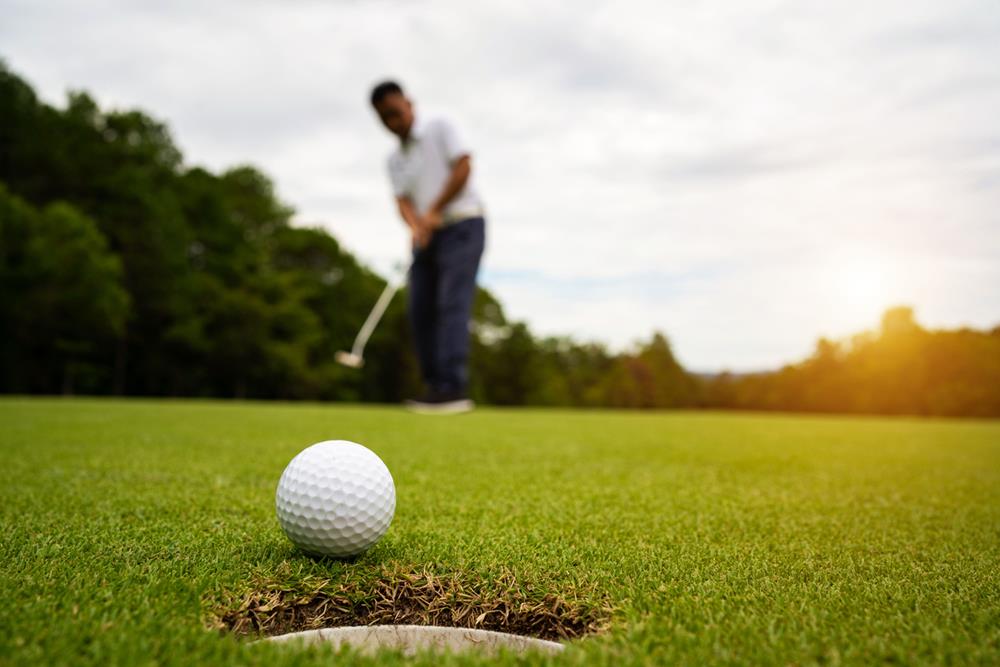Golf is a fun sport that lots of people around the world enjoy. Whether you want to play for fun, to relax, or to compete with friends, golf can be a great choice. Starting something new can sometimes feel a bit tricky, but don’t worry! In this guide, we’ll show you the simple steps to get into golf.
From hitting balls at the driving range to choosing the right golf course and gear, we’ve got you covered. We’ll also talk about why it’s a good idea to learn from a teacher, how to hold your golf club properly, and ways to get better at the shorter shots. So, if you’re thinking about giving golf a try, you’re in the right place to learn how to start.
Hit the Range
Hitting the range is your first step into the world of golf, and it’s all about heading to a driving range. Think of a driving range as a practice field where you can hit golf balls as far as you can without worrying about playing a full game on a course. It’s a perfect spot for beginners because it’s all about getting used to the feel of swinging a golf club and striking the ball.
Why Start at the Range?
- Learn the Basics: Before you can master the golf course, you need to understand how to hit the ball. The range gives you space and freedom to practice your swing, see how the ball flies, and get immediate feedback on what works and what doesn’t.
- Build Confidence: It can be daunting to step onto a golf course as a beginner. The range is a low-pressure environment where mistakes are part of the learning process, allowing you to build confidence as you improve.
- Discover Your Style: Everyone’s swing is a bit different. The range is where you’ll start to discover your unique style and what feels comfortable for you.
Tips for Your First Range Visit
- Start with a Warm-Up: Like any sport, warming up is crucial in golf to avoid injuries. Begin with some stretches and light swings to get your muscles ready.
- Choose the Right Clubs: Don’t worry about having a full set of clubs right away. Start with a driver or an iron (like a 7-iron) to get the hang of hitting the ball. These clubs are versatile and forgiving for beginners.
- Focus on Form, Not Distance: It’s exciting to see how far you can hit the ball, but when you’re starting, it’s more important to focus on good form. Work on consistent, smooth swings, and the distance will follow.
- Take Your Time: The driving range is not a race. Take your time with each shot; think about your stance, grip, and swing. Rushing can lead to bad habits.
- Consider a Bucket Size: You don’t need the largest bucket of balls on your first go. Start with a small or medium-sized bucket so you can focus on each shot without feeling overwhelmed.
Hitting the range is an exciting first step into golf. It’s all about practice, patience, and getting a feel for the game. With each visit, you’ll see improvements in your swing, confidence, and overall understanding of golf.
Find the Right Course
Finding the right golf course is a crucial step for beginners in golf. The course you choose can greatly influence your enjoyment and development in the game. It’s not just about finding a beautiful course but also one that matches your skill level and makes you feel comfortable as you learn.
Factors to Consider
- Difficulty Level: Look for courses that are friendly to beginners. These courses usually have fewer hazards like water and bunkers, and the fairways are wider. Playing a course that is too difficult too soon can be frustrating and may discourage you.
- Location: Consider courses that are conveniently located. If the course is too far away, you might find it hard to practice regularly. Regular play is key to improvement, so accessibility matters.
- Fees and Memberships: Golf can be expensive, but there are options for every budget. Some courses offer discounts for beginners or special rates during off-peak hours. Look for deals and consider whether you prefer to pay as you go or invest in a membership.
Beginner-Friendly Courses
Beginner-friendly courses are designed to be more forgiving. They often feature:
- Shorter Distances: These courses have shorter holes, which can be less intimidating for new golfers and provide a sense of achievement when you complete them.
- Less Complexity: With fewer hazards and simpler layouts, these courses let you focus on improving your basic skills without too many obstacles.
- Practice Facilities: Look for courses with good practice facilities, such as driving ranges, putting greens, and chipping areas. These facilities allow you to warm up before your round or work on specific aspects of your game.
Recommendations for Choosing Your Course
- Ask Around: Talk to fellow golfers or search online for recommendations on beginner-friendly courses in your area. Golf communities are often very welcoming and can provide valuable insights.
- Visit the Course: Before playing, consider visiting the course to get a feel for the atmosphere and facilities. This visit can also give you a chance to ask about beginner programs, lessons, or clinics they might offer.
- Read Reviews: Online reviews can provide a sense of what to expect from a course, from the condition of the greens to how crowded it might get on weekends.
Choosing the right golf course is about finding a place where you can comfortably grow and enjoy the game. As you progress, you can challenge yourself with more difficult courses, but in the beginning, focus on finding courses that match your current level.
Getting the Gear
Getting the right gear is an exciting part of starting your golf journey. The right equipment can make a big difference in how you play and enjoy the game. Here’s how to navigate the process of getting your golf gear without breaking the bank or getting overwhelmed by the options.
Essential Gear for Beginners
- Golf Clubs: You don’t need a full set right away. Start with the basics: a driver, a putter, and a few irons (like the 5, 7, and 9 irons) are enough to get you going. These clubs will help you cover a wide range of shots.
- Golf Balls: As a beginner, choose balls that are designed for durability and distance. Don’t worry about advanced features like spin control; focus on balls that will forgive your mis-hits.
- Gloves: A good golf glove can help improve your grip on the club, especially in hot or humid conditions. You’ll only need one glove for the hand that’s at the top of the club when you grip it.
- Tees and Markers: You’ll also need tees (the small pegs you put your ball on at the start of each hole) and ball markers (used on the greens to mark your ball’s position).
Buying Golf Gear on a Budget
- Second-hand Clubs: Buying used clubs can save you a lot of money. Look for second-hand sports stores, online marketplaces, or golf forums. Just make sure the clubs are in good condition and suited to your height and swing style.
- Prioritize Your Purchases: Focus on what you need most. A reliable set of clubs and a comfortable pair of shoes are more important than the latest golf gadgets.
- Watch for Sales and Discounts: Golf stores often have sales at the end of the season. Signing up for newsletters or following stores on social media can alert you to discounts.
Tips for Selecting Your Gear
- Club Fitting: Consider getting fitted for your clubs. A professional fitting ensures your clubs are tailored to your body and swing, which can significantly improve your game.
- Comfortable Clothing and Shoes: Golf involves a lot of walking and time spent outdoors. Choose clothes that are comfortable and suitable for the weather. Golf shoes should provide stability and support during your swing.
- Bags: A good golf bag keeps your clubs organized and makes it easy to carry them around the course. There are two main types: stand bags (lighter and designed to be carried) and cart bags (larger and designed for use with a golf cart).
Starting with the right gear sets you up for a successful and enjoyable golf experience. Remember, the best gear for you is what fits your body, your budget, and your game style.
Get a Teacher
Getting a teacher is a smart move when you’re new to golf. A good instructor can speed up your learning process, help you avoid common mistakes, and build a solid foundation for your game. Here’s how to make the most of getting a golf teacher.
The Importance of Professional Instruction
- Faster Progress: A teacher can provide personalized feedback and adjustments that are hard to figure out on your own. This tailored advice can help you improve much faster than going it alone.
- Correcting Bad Habits: It’s easy to develop bad habits in golf, especially if you’re self-taught. A teacher can spot and correct these habits before they become ingrained in your swing.
- Building Confidence: Having a professional guide can boost your confidence in the course. Knowing you’re learning the correct techniques makes the game more enjoyable and less frustrating.
Finding the Right Teacher
- Check Credentials: Look for a teacher with recognized credentials from a golf association or teaching academy. Certified professionals have undergone specific training to teach golf effectively.
- Ask for Recommendations: Talk to fellow golfers or staff at your local golf course. Personal recommendations can lead you to great instructors who’ve helped others improve.
- Consider Your Goals: Different teachers have different strengths. Some might be great with beginners, while others specialize in advanced techniques or mental game strategies. Consider what you want to achieve and look for a teacher who matches your goals.
What to Expect from Golf Lessons
- Assessment: Your teacher will likely start with an assessment of your current skill level, including your swing, grip, posture, and any specific challenges you face.
- Customized Plan: Based on the assessment, you’ll get a customized lesson plan. This plan will focus on your needs, whether it’s mastering the basics or working on specific aspects of your game.
- Practice, Feedback, and Adjustments: Lessons typically involve practicing specific drills or techniques, receiving feedback, and making adjustments. Your teacher will provide immediate feedback on what you’re doing well and what needs improvement.
- Homework: Expect to get some homework. Practicing between lessons is crucial for reinforcing what you’ve learned and making steady progress.
Tips for Working with a Teacher
- Be Open and Honest: Share your goals, fears, and any areas you’re struggling with. The more your teacher knows, the better they can help you.
- Practice Consistently: Make the most of your investment by practicing regularly. Even short, focused practice sessions can lead to big improvements.
- Stay Patient: Progress in golf can sometimes feel slow. Trust your teacher’s process and be patient with yourself as you learn and grow.
Getting an instructor is one of the best steps you can take as a beginner golfer. With professional guidance, you can enjoy the learning process, improve your game, and avoid common pitfalls that might hold you back.
Practice the Grip
Practicing the grip is fundamental in golf, as it’s the only point of contact you have with the club and significantly influences the outcome of your swing. A proper grip can enhance your control, accuracy, and power. Here’s how to get started and what to keep in mind.
Understanding the Basics of the Grip
- Types of Grips: There are several grip types – the interlocking grip, the overlapping grip, and the baseball grip. Beginners usually find the baseball grip easier to learn, but experimenting with each type can help you discover what works best for your swing.
- Grip Pressure: Your grip on the club should be firm yet relaxed. Gripping too tightly can hinder your swing’s fluidity and reduce power, while too loose a grip can cause the club to slip during the swing.
- Hand Placement: For a right-handed golfer, place your left hand at the top of the club handle, with your right hand directly below it. The V-shape formed by your thumb and forefinger on each hand should point towards your right shoulder. The positions are reversed for left-handed golfers.
Practicing Your Grip
- Daily Practice: You don’t need to be at the golf course or driving range to practice your grip. Spend a few minutes each day holding a club or a grip trainer to build muscle memory.
- Mirror Work: Use a mirror to check your grip alignment and hand placement. This visual feedback can help correct any inconsistencies and ensure your V-shapes are pointing in the right direction.
- Grip Checks: Regularly check your grip before and after swings when you practice. This reinforces the habit of correctly gripping the club each time you play.
Common Grip Mistakes to Avoid
- Over-gripping: Gripping the club too tightly can restrict your swing and lead to less powerful shots. Aim for a grip pressure that’s firm enough to control the club but relaxed enough to allow for a smooth swing.
- Incorrect Hand Placement: Ensure your hands are placed on the club in a way that promotes a cohesive and unified swing. Incorrect hand placement can lead to issues like slicing or hooking the ball.
- Lack of Consistency: Consistency in your grip is key to developing a reliable swing. Practice your grip regularly to ensure it becomes second nature.
Why the Grip is So Important
Your grip affects nearly every aspect of your golf game. It influences the clubface’s orientation at impact, the swing path, and, ultimately, the flight of the ball. By dedicating time to practice and perfecting your grip, you’re laying the foundation for a stronger, more accurate game.
Work on Your Shorter Shots
Working on your shorter shots is vital in golf, often making a significant difference in your score. Short game shots, including putting, chipping, and pitching, require precision and finesse rather than power. Here’s how to improve these crucial parts of your game.
The Importance of Short Shots
- Lowering Your Score: Many golfers focus on driving distance, but short shots are where games are won or lost. Improving your short game can drastically lower your scores since you’re often closer to the hole.
- Building Confidence: Excelling in your short game builds confidence on the course. Knowing you can rely on your chipping and putting under pressure makes the game less stressful and more enjoyable.
- Adapting to Challenges: Short shots are often needed in challenging situations, like getting out of the rough or navigating hazards. Mastery here means you can handle whatever the course throws at you.
Practicing Putting
- Consistent Routine: Develop a consistent pre-putt routine to improve focus and accuracy. This routine can include reading the green, aligning your shot, and taking practice strokes.
- Distance Control: Practice putting from different distances to get a feel for power and control. Use drills that focus on maintaining a consistent stroke length and speed.
- Aiming Drills: Use aids like alignment sticks to ensure your putter face is square at impact, improving accuracy.
Improving Chipping
- Club Selection: Understand how different clubs (like a 7-iron vs. a wedge) affect your chip shots’ distance and loft. Experiment with various clubs to see how they change the trajectory and roll of the ball.
- Body Position: Work on maintaining a steady lower body during your chip shots. A stable base helps with consistency and control.
- Strike Practice: Practice hitting the ball with a descending blow, which ensures you get under the ball and lift it properly. This technique is key to successful chipping.
Enhancing Pitching
- Swing Tempo: Focus on maintaining a smooth tempo. A rushed or slowed swing can lead to inconsistency in your pitching.
- Follow Through: Ensure you’re completing your swing with a follow-through. This commitment to the shot helps with distance control and accuracy.
- Distance Drills: Similar to putting, practice pitching from various distances to develop a keen sense of how hard to hit the ball based on your position relative to the hole.
Tips for All Shorter Shots
- Practice with Purpose: When practicing your short game, have specific goals for each session. Whether it’s improving your putting accuracy or getting comfortable with chip shots, focused practice is more effective than aimless hitting.
- Mental Game: Short shots can be pressure-filled, especially in tight matches. Work on your mental game by practicing these shots under simulated pressure conditions, like imagining you’re playing in a tournament.
- Get Feedback: Use technology or a coach to get feedback on your technique. Slow-motion video can be particularly enlightening for understanding your stroke and making necessary adjustments.
Focusing on your shorter shots can transform your golf game, turning challenging situations into opportunities to save or even lower your score. Regular, focused practice on these elements will not only improve your performance but also increase your enjoyment of the game.
Conclusion
Getting into golf involves a few key steps that set the foundation for a rewarding experience. Start by hitting the range to get comfortable with swinging and hitting the ball. Find a course that suits beginners so you can play without feeling overwhelmed. Gear up with the essential equipment without overspending, focusing on what truly benefits your game.
Consider getting a teacher to fast-track your improvement and avoid common pitfalls. Don’t overlook the importance of mastering your grip and spending time on your short game, as these aspects are crucial for lowering your scores. With patience, practice, and a positive attitude, you’ll find yourself enjoying the game and constantly improving. Welcome to the wonderful world of golf!
Additional Ideas
- You can spend all day hitting balls without worrying about how you look—everyone’s either a beginner or has been one. It’s a perfect opportunity to work on your golf swing and shots for what comes next.
- To seriously improve at golf, investing in gear, especially clubs is essential. Start by understanding the different clubs and their functions. As recommended by professional coaches at https://theleftrough.com/, always check gear reviews before making any purchases.
- Golf requires expert guidance beyond YouTube tutorials to help improve your game. Consider hiring a golf instructor for in-person lessons or opt for the convenience of online golf lessons to enhance your game.

